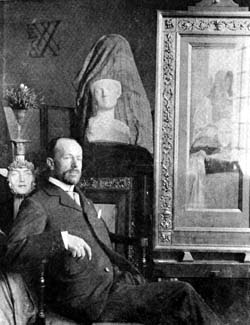

Fernand Khnopff was born to a wealthy family that was part of the high bourgeoisie for generations. Khnopff's ancestors had lived in Flanders since the early 17th-century but were of Austrian and Portuguese descent. Most male members of his family had been lawyers or judges, and young Fernand was destined for a juridical career. In his early childhood (1859-1864) he lived in Bruges where his father was appointed Substitut Du Procureur Du Roi. His childhood memories of the medieval city of Bruges would play a significant role in his later work. In 1864 the family moved to Brussels.
|
To please his parents he went to law school at the Free University of Brussels (now divided into the Université Libre de Bruxelles and the Vrije Universiteit Brussel) when he was 18 years old. During this period he developed a passion for literature, discovering the works of Baudelaire, Flaubert, Leconte de Lisle and other mostly French authors. With his younger brother Georges Khnopff - also a passionate amateur of contemporary music and poetry - he started to frequent Jeune Belgique ("Young Belgium"), a group of young writers including Max Waller, Georges Rodenbach, Iwan Gilkin and Emile Verhaeren. |
|
|
|
Khnopff left University due to a lack of interest in his law studies and began to frequent the studio of Xavier Mellery, who made him familiar with the art of painting. On the 25th of October 1876 he enrolled for the Cours De Dessin Après Nature ("course of drawing after nature") at the Académie Royale des Beaux-Arts en Bruxelles. At the Académie, his most famous fellow student was James Ensor, whom he disliked from the start. Between 1877 and 1880 Khnopff made several trips to Paris where he discovered the work of Delacroix, Ingres, Moreau and Stevens. At the Paris World Fair of 1878 he became acquainted with the oeuvre of Millais and Burne-Jones. During his last year at the Académie in 1878-1879 he neglected his classes in Brussels and lived for a while in Passy, were he visited the Cours Libres of Jules Joseph Lefebvre at the Académie Julian. |
|
Early career with Les XX
|
|
|
|
Khnopff: The Caress Mature
Years
|
|
From 1900 onwards Khnopff is
engaged in the design of his new home and studio in Brussels
(demolished). The house was inspired by the Vienna Secession and more in
particular by the architecture of Joseph Maria Olbrich. To the sober
architecture and decoration Khnopff added a highly symbolic, spatial and
decorative concept that turned his home into a "Temple of the
self". The house functioned as a shrine in which the genius of the
painter could flourish. His motto "On a que soi" (=One has but
oneself) was inscribed above the entrance door, in and his studio he
painted in the middle of golden circle inscribed on the white mosaic
floor[4]. This almost theatrical setting was undoubtedly a reflection of
Khnopffs passion for theatre and opera. Khnopff's first designs for the
theatre date from 1903 when he sketched the sets for a production of
Georges Rodenbach's play "Le Mirage" at the Deutsches Theater
Berlin. This production was directed by the famous Max Reinhardt, and
the sets evoking the gloomy streets of the mysterious city of Bruges
where Khnopff had spend his early childhood, were much appreciated by
the Berlin public and critics. After Khnopff had been engaged to design
the costumes and the sets for the World premiere of Ernest Chausson's
opera Le Roi Arthus at the Théâtre Royal de la Monnaie in Brussels in
1903, he collaborated on more than a dozen opera productions given at
"La Monnaie" in the following decade[5]. In 1904 the city
council of Saint Gilles commissioned him to decorate the ceilings of the
"Salle des Marriages" (=Wedding Room) of the new Town Hall,
and in the same year he was approached by the wealthy banker Adolphe
Stoclet to design decorative panels for the music room of the Palais
Stoclet. Here Khnopff came in touch again with prominent artists from
the Vienna Secession; the architect of the Palais Stoclet Josef
Hoffmann, and Gustav Klimt who had designed a decorative mosaic for its
dining room.
|
|
|
|
Although not a very open man and a rather secluded personality, he already achieved cult status during his life. Acknowledged and accepted, he received the Order of Leopold. His sister, Marguerite, was one of his favorite subjects. His most famous painting is probably The Caress ("L'Art ou Des Caresses"). His art often portrayed a recurring theme found in symbolist art: the dualistic vision of woman as either 'femme fatale' or angelic woman.
|
|
|
|
|
|
|
|
|
|
This tribute site, FernandKhnopff.com is maintained by Antonio Roybal.
Please also visit the myspace page for Fernand Khnopff: http://www.myspace.com/khnopffart